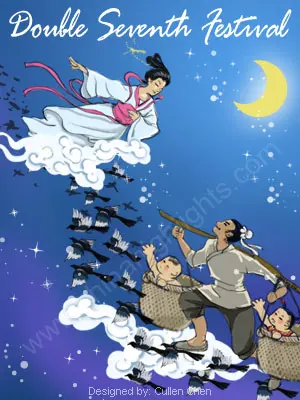
The Qixi Festival (Double Seventh Festival) is one of Chinese traditional festivals, and also known as the Chinese Valentine’s Day. It’s based on a romantic legend about a weaver girl and an ox herd. It falls on the 7th day of the 7th Chinese lunar month.
https://www.chinahighlights.com/festivals/double-seventh-festival.htm
The Qixi Festival (Double Seventh Festival) is one of Chinese traditional festivals, and also known as the Chinese Valentine’s Day. It’s based on a romantic legend about a weaver girl and an ox herd.
It falls on the 7th day of the 7th Chinese lunar month. In 2023 that’s August 22 (Tuesday). There is no public holiday.
Qixi Festival Facts
- Chinese Name: 七夕节 Qīxījié /chee-sshee-jyeah/ ‘Seventh Evening Festival’
- Date: August 22, 2023 (month 7 day 7 of the Chinese lunar calendar)
- History: over 2,000 years
- Celebrations: giving gifts (flowers, chocolates, ties…) to romantic partners, romantic dates – dinners, movies, etc.
The Quick Version…
An oxherd Niulang with the help of his ox (the demoted cattle god) married a fairy, Zhinü, who became a weaver girl. Zhinü’s mother, a goddess, returned Zhinü to heaven. Niulang pursued using the ox’s hide. The goddess separated them by a river of stars (the Milky Way), but magpies were allowed to form a bridge for them to meet once a year (Qixi).
For the longer version, see China’s Top Romantic Legends.
https://www.chinahighlights.com/travelguide/article-famous-love-stories-chinese-valentine-day.htm
Tianzhu Mountain: Whispers Beneath the Magpie Bridge
 A picture of the Double Seventh legend
A picture of the Double Seventh legend
Located in Qianshan County of south-west Anhui Province, Tianzhu Mountain gets its name from its highest peak. On Tianzhu Mountain, traces of the Seven Fairies can be seen everywhere. It is said that Tianchi Peak (天池峰) was where they first descended. Also, there is Duxian Bridge (渡仙桥) and Tianchi (天池) which is for the Heavenly Queen Mother to bathe in.
The overall highlight is Magpie Bridge. On reaching Datianmen (大天门), Magpie Bridge is seen right before your eyes. It is like an upright overpass crossing over the cliff and visitors can circle down along the stone steps under the bridge. It represents the bridge of magpies the cowherd and the weaving maid meet on during the Magpie Festival (Double Seventh, Qixi, or Chinese Valentine’s Day).
The Legend of the Cowherd and the Weaver Fairy
There once was a young, poor, but kind-hearted cowherd called Niulang, and an old ox. The ox actually was once the god of cattle, but downgraded as he had violated the law of heaven. Niulang once saved the ox when it was sick. In order to show its gratitude, the old ox helped Niulang get acquainted with Zhinü (a fairy, the seventh daughter of a goddess and the Jade Emperor) when she escaped from her boring life in heaven to look for fun on earth.
Zhinü soon fell in love with Niulang and they got married without the knowledge of the goddess. Niulang and Zhinü lived a happy life together; Niulang worked in the field while Zhinü did weaving at home. After a few years passed, they had two children, one boy and one girl.
However, the Goddess of Heaven (Zhinü’s mother) found out that Zhinü, a fairy girl, had married a mere mortal. The goddess was furious and sent celestial soldiers to bring Zhinü back. Niulang was very upset when he found his wife was taken back to heaven. Then his ox asked Niulang to kill it and put on its hide, so he would be able to go up to heaven to find his wife. Crying bitterly, he killed the ox, put on the skin, and carried his two beloved children off to heaven to find Zhinü.
Just before he caught up with Zhinü the goddess of heaven took out her hairpin and created a huge river between them, and they were separated forever by the river that later became known as the Milky Way.
Heartbroken, he and his children could only weep bitterly. However, their love moved all the magpies to take pity on them, and they flew up into heaven to form a bridge over the river, so Niulang and Zhinü could meet on the magpie bridge. The goddess was also moved by their love, so she allowed them a meeting on the magpie bridge on that day every year (the seventh day of the seventh lunar month).